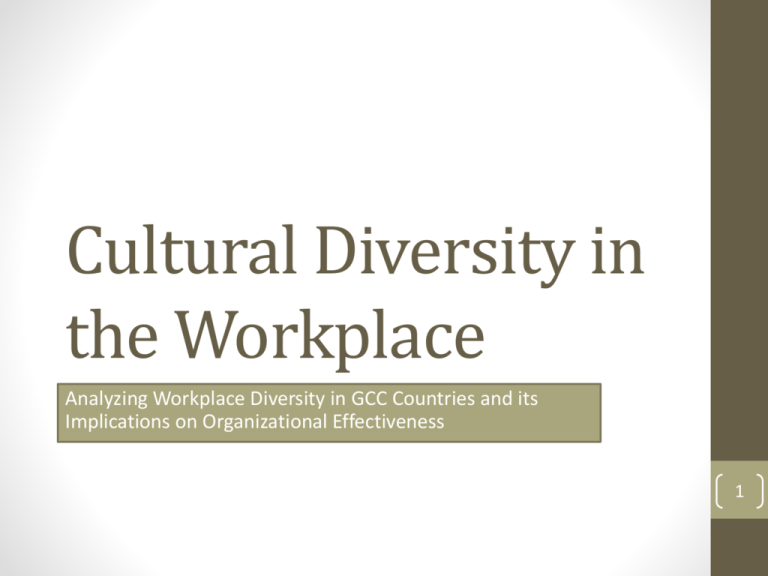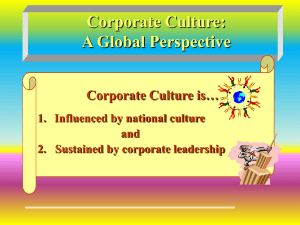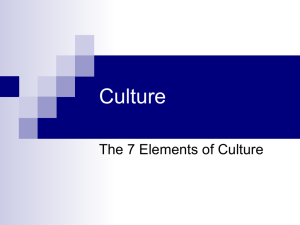Cultural Diversity in the Workplace
advertisement

Cultural Diversity in the Workplace Analyzing Workplace Diversity in GCC Countries and its Implications on Organizational Effectiveness 1 We do not see things as they are; we see things as we are - Talmud Bavli Ancient Book of Wisdom, Babylonia 2 The Challenge of Workplace Diversity? • The challenge lies in the continuous improvement of the integration and social acceptance of people from different backgrounds. • Our differing human characteristics influence the way we think, act, interact, and make choices. • Often, these differences interfere with our ability to support, trust, and respect each other, and thus to effectively function together. 3 Workplace IntegrationNationalization The “GCC Paradox”- a unique phenomenon Omanization, Saudization, Emiratization, Qatarization….. Expatriate shaped workplace culture Expat majority Ignorance of “cultural diversity” “Shadowing” 4 Types of Diversity • Gender • Age • Race • Ethnicity • Culture • Religion • Language/Accent • Disability • Height/Weight • Sexual Orientation • Education • Job Title • Job Function • Job Skills • Union/Non-Union • Part-Time/Full-Time • Marital Status • Political affiliation 5 Valuing Diversity Diversity does not pit one culture against another for dominance; it only allows for cultural differences to be employed to solve business challenges. Diversity acknowledges and uses these inherent differences to drive innovation as a way of creating better organizational performance and competitive advantage. 6 Understanding Workplace Diversity • The organization is diverse by default, and employees must be able to deal with it. • The goal is to fix, cover-up, and/or defer the problem with a minimum of hassle. • The effort is top management-driven, thus forced throughout the organization. • The concern is more for a change in behavior than attitudes (=individual culture). 7 Layers of Organizational Culture Cultural Symbols Shared Behaviors Cultural Values Shared Assumptions 8 How Cultures Emerge Top Management • Agrees on shared assumptions of human behavior • Develops a shared vision of cultural values Behaviors Results Culture • Employees behave in ways that are consistent with shared values and assumptions • Financial performance • Strong culture emerges • Market share • Traditions are maintained • Employee commitment • Socialization practices for new employees 9 Thoughts on Culture • Everyone creates culture—every person, group, family, organization. • Culture is what everyone knows that everyone else knows. It is a way of understanding and living in the world. • Cultures are defined by their differences from other cultures. The greater the difference, the more defined the culture. • The most important aspects of culture are those not talked about. • People from different cultures experience different realities. • Most cultures accept differences in power and status, and consider it normal. Primates always rank order. • Most cultures value conformity, reward compliance, and punish descent. 10 Culture provides its members with… • Self identity: Who am I? • Belongingness and social support: Where do I belong? • Guidelines for behavior: What should I do or not do? • Sense of purpose: Why am I here? • Predictability and security: What will happen to me? 11 Characteristics of Culture • Culture is shared by members of a group and sometimes define the membership of the group itself. • Culture is learned though membership in a group or community. • Culture influences the attitudes and behaviors of group members (e.g., normative behavior). 12 Definitions of Culture • The collective programming of the mind that distinguishes the members of one human group from another. (Geert Hofstede) • The collection of beliefs, values, behaviors, customs, and attitudes that distinguish the people of one society from another. (Clyde Kluckholm) • Shared motives, values, beliefs, identities and interpretations or meanings of significant events that result from common experiences of members of collectives that are transmitted across generations. (Robert House and GLOBE associates) • A toolkit of symbols, stories, rituals, traditions and worldviews that help the people of a culture survive and succeed. (Ann Swidler) 13 The Ideal Work Culture Strong cultures: • Commit members to do things that are in the best interests of the organization. • Discourage dysfunctional work behavior. • Encourage functional work behavior. The best organizations have strong cultures that: • • • • • Are performance-oriented. Emphasize teamwork. Allow for risk taking. Encourage innovation. Value the well-being of people. 14 What is organizational culture? Diagnostic questions for assessing cultural differences: • How tight or loose is the structure? • Are decisions change oriented or driven by the status quo? • What outcomes or results are most highly valued? • What is the climate for risk taking, innovation? • How widespread is empowerment, worker involvement? • What is the competitive style, internal and external? 15 Cultural DimensionsGeert Hofstede 16 Cultural Trends: Central Europe and the GCC Austria/Germany GCC • Low power distance • High power distance • High individualism • Medium individualism • Low “masculinity” • High “masculinity” • Medium uncertainty avoidance • High uncertainty avoidance • Long-term oriented • Short to mid-term oriented 17 Avoiding Cultural Stereotypes When describing another group, cultural descriptions… Should provide accurate descriptions of the beliefs, values, and social norms of a group. Should be limited to objective characteristics and avoid evaluative components (e.g., good or bad). Should be considered a first best guess about the behaviors of another group prior to developing more specific information about individual members of the group. Should recognize that they contain limited information that can mask other useful data about cultural diversity. Should be modified over time as new information about a group is discovered through observation and experience. 18 Express your View on Cultural Differences 1. Do you personally have any stereotypes about people from other cultures? What concrete steps can you take to: o 1. Avoid cultural stereotyping (out-group stereotyping)? o 2. See cultural differences in neutral terms? o 3. Go beyond the superficial differences between people and understand the motivational bases of individuals and groups from different cultures? 19 Culture Comparisons What words describe your personal culture versus another? What…. • …is your most prominent personality characteristic? • …is your most positive characteristic and/or contribution? • …is your worst characteristic and/or contribution? • …are your characteristics as co-worker? • …would you like to better know about “them”? 20 Cultural Complexities and Contradictions: Group Discussion 1. Identify some ways in which managers can prepare for such challenges prior to arriving on site? 2. Once they have arrived and are confronted with such challenges, how might managers respond? 3. Is there a “toolkit” here that can prepare managers to cope with such seeming contradictions in the field? Students, please organize yourself in mixed working teams of 4-5 persons per group, identify problems and discuss possible answers. Nominate 1-2 speakers to present (5 minutes verbal presentation per team) 21 Levels of Mental Programming Personality (inherited and learned; specific to individual) 22 Example: Culture and Normative Behavior Western vs Islamic Banking • In the West, bank customers expect to receive interest on their deposits. In Islamic banking, the holy Qur’an prohibits paying or receiving interest; this is seen as taking advantage of others who are less fortunate. Instead, bank customers entrust funds to banks in exchange for profit-sharing (mudaraba). • In the West, stock market transactions are open to investments and speculation in almost anything. Under Islamic law, only investments in economic activities that are consistent with the values of Islam are acceptable (halal). What is the impact of such differences when doing business across borders? 23 Members vs Non-Members Example: Perception of Foreigners Definition: “A foreigner is a person born in another country; an alien; a person regarded as an outsider or stranger.” Xenophobia: A fear or dislike of strangers or foreigners. All cultures differentiate between members and nonmembers or foreigners, and all countries have some people who are xenophobic. Consider: 1. In your world, does “foreigner” have a good or bad connotation? Are foreigners threats or opportunities? 2. How can foreigners become members of your particular culture or society? 24 Does Culture affect Motivational Factors? Discussion Question One of the core principles that one needs to know when working in teams or managing people is to understand individual intrinsic and extrinsic motivational factors: What is motivating you? • • • • • • Praise Promotion Financial Compensation Recognition Equity (feeling equal to peers) Challenge • • • • • • Challenge Autonomy Responsibility Social Contacts Self-Actualization … 25 Core Cultural Dimensions Hierarchical Power Distribution Egalitarian Individualistic Social Relationships Collectivistic Mastery Environment Relationships Harmony Monochronic Time/work patterns Polychronic Rule-based Uncertainty and social control Relationshipbased 26 Power Distribution Hierarchical • Centralized • Belief that power should be distributed hierarchically across society • Belief in ascribed or inherited power with ultimate authority residing in institutions • Emphasis on organizing vertically and autocratic or centralized decision-making • Emphasis on who is in charge • Acceptance of authority; reluctance to question authority Egalitarian • Decentralized • Belief that power should be distributed relatively equally across society • Belief in shared or elected power with ultimate authority residing in the people • Emphasis on organizing horizontally and participatory or decentralized decision-making • Emphasis on who is best qualified • Rejection or skepticism of authority; willingness to question authority 27 Social Relationships Individualistic Collectivistic • Person-centered • Group-centered • Belief that people achieve selfidentity through individual accomplishment • Belief that people achieve selfidentity through group membership • Focus on accomplishing individual goals • Preference for preserving social harmony over individual rights • Focus on accomplishing group • Sanctions reinforce independence goals and personal responsibility • Sanctions reinforce conformity to • Contract-based agreements group norms • Tendency toward low-context • Relationship-based agreements (direct, frank) communication and • Tendency toward high-context individual decision-making (subtle, indirect) communication and group or participative decisionmaking 28 Environmental Relationships Mastery-oriented • Dominance over nature • Focus on changing or controlling one’s natural and social environment • Achievement valued over relationships • Emphasis on competition in the pursuit of personal or group goals • Embraces change and unquestioned innovation • Emphasis on material possessions as symbols of achievement • Emphasis on assertive, proactive, “masculine” approach • Preference for performance-based extrinsic rewards Harmony-oriented • Accommodation with nature • Focus on living in harmony with nature and adjusting to the natural and social environment • Relationships valued over achievement • Emphasis on social progress, quality of life, and the welfare of others • Defends traditions; skepticism towards change • Emphasis on economy, harmony, and modesty • Emphasis on passive, reactive, “feminine” approach • Preference for seniority-based intrinsic rewards 29 Time and Work Patterns Monochronic Polychronic • Linear • Non-linear • Sequential attention to individual tasks • Simultaneous attention to multiple tasks • Single-minded approach to work, • Interactive approach to work, planning, and implementation planning, and implementation • Precise concept of time; punctual • Flexible concept of time; often late • Job-centered; commitment to the job and often to the organization • People-centered; commitment to people and human relationships • Separation of work and personal life • Integration of work and personal life • Approach to work is focused and impatient • Approach to work is at times unfocused and patient 30 Uncertainty and Social Control Rule-based Relationship-based • Individual behavior should be largely regulated by rules, laws, formal policies, standard operating procedures, and social norms that are widely supported by societal members and applied uniformly to everyone. • While rules and laws are important, they often require flexibility in their application or enforcement by influential people (e.g., parents, peers, superiors, government officials) or unique circumstances. • Emphasis on legal contracts and meticulous record keeping. • Emphasis on interpersonal relationships and trust; less emphasis on record keeping. • Low tolerance for rule breaking. • Decisions based largely on objective criteria (e.g., legal constraints, data, policies). • Moderate tolerance for rule breaking. • Decisions often based on subjective criteria (e.g., hunches, personal connections). 31 Discussion: Approaching Cultural Differences • • • • Cultural differences often influence how we think and see things, suggesting that different people may have different understandings of the same situation, and may act differently as a result. As groups interact with one another, however, new understanding and new behaviors can emerge. Over time, managers learn to negotiate new ways to relate to others. Cultural differences within a group can often lead to better decisions. Under what circumstances and why might this be the case? What are the stimulants? When managers from two or more cultures come in contact, the starting point for interaction is usually what the different groups bring to the table, but the end result will likely depend more on their interactions, the managers and their organizations, power differentials, and the exchanges that take place (cultural friction). 32 Cultural Complexities and Contradictions On the one hand, cultures: 1. 2. 3. 4. 5. Are stable over time. Typically reinforce holistic behavior. Often exhibit defining characteristics of its people. Often help explain the past or current behaviors of its members. Highlight key characteristics of the predominant group. On the other hand, cultures: 1. 2. 3. 4. 5. Evolve over time. Often tolerate fragmented behavior. Often exhibit numerous exceptions to its defining characteristics. May not always help in predicting the future behaviors of its members. Often mask important subcultures (e.g., religious or ethnic, regional). 33 Your Business Case Multicultural Teams You are the marketing manager of XYZ Construction AG, a German head-quartered organization that operates internationally, but has not yet been able to get foothold in the Middle East. The company targets a market entry to Oman, UAE and Qatar in the second half of 2012. XYZ is specialized in marine construction, and upcoming port and offshore construction projects in the Middle East coupled with lower revenues from their European operations, have attracted the attention of the company’s management. You have therefore been assigned to compose a task team (employee selection) and are requested to compile a proposal (methodology) for a comprehensive market study (focus on competition, buyers and suppliers) and suggest an approach how to best enter the market by respecting cultural differences and consumer/buyer patterns. 34 Your Business Case Multicultural Teams 1. You will lead the new task team (3 members excluding you) and will first have to decide on the selection of team members (technical, social skills). You are requested to look for great cultural diversity in your team in respect of the ethnically diverse culture in the Middle East. Whom will you select? 2. At the launch meeting, your first order of business is to insure that all team members understand their cultural differences and similarities, as well as how they can build on this to develop a cohesive and effective work team. How are you going to organize and run this meeting to accomplish your goal? 35 Your Business Case Multicultural Teams 3. You are requested to submit a proposal of how you are going to approach the compilation of your market research and will need to suggest what information is important to make valid conclusions. What do you need to know in order to ensure validity of your findings? (significant market potential and industry growth is assumed!!!) 4. What, in your expectation, will be the best approach to sensibly and effectively commence marketing activities? What cultural differences are most crucial to be respected? Consider a stakeholder approach to marketing! 36 New Markets XYZ is planning to capture new market segments through an offensive marketing strategy, therefore you will have to look at the underlying forces in order to identify the market potential. Industry Dynamics Threat of New Entrants Bargaining Powers of Suppliers Threat of Substitutes Bargaining Powers of Buyers Competitive Rivalry Strength and weaknesses of competitors Porter’s Five Forces Source: Macmillan & Tampoe, 2000, p. 248 37 Marketing DELIVERING CUSTOMER VALUE Choosing the Value Providing the Value Communicating the Value Improved Competitiveness Source: “SKS 7000” , 2011, p. 132 38 Positioning- The External Environment of Organizations Companies may achieve competitive advantage in many ways, including: • Products • Pricing • Customer service • Cost efficiency • Quality 39 Useful Managerial Skills • • • • • • Self-awareness: Understand who you are and what you stand for. Empathy: Seek to understand the attitudes and behaviors of others. Information gathering and analysis: Seek to discover some of the less obvious cultural assumptions of others. Information integration and transformation: Work to make sense out of new information about others. Behavioral flexibility: Build a capacity to approach problems and situations in multiple ways, using different techniques. Mindfulness: Pay attention to what is happening around you, both with yourself and others. 40 Food for Thought "There is no better fertile ground for innovation than a diversity of experience. And that diversity of experience arises from a difference of cultures, ethnicities, and life backgrounds. A successful scientific endeavor is one that attracts a diversity of experience, draws upon the breadth and depth of that experience, and cultivates those differences, acknowledging the creativity they spark." Dr. Joseph M. DeSimone 41 Resources • McCuddy, M.K. (1997). Cultivating organizational culture. Retrieved from www.mcm.edu/~lapointp/OBPowerpointslides13thed/Chapter _15.ppt • Steers, R.M, Sanchez-Runde, C.J. & Nardon, L. (2009). Culture values and world views. Retrieved from www.cambridge.org/resources/052151343X/8228_PPT3Culture.ppt • White, B. (2004). Diversity in the workplace. Retrieved from instructional1.calstatela.edu/wwhite/Bus200/Bus%20200-Diversity.ppt 42






